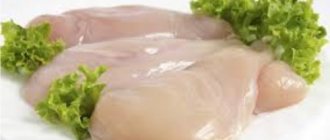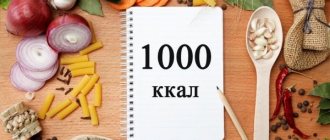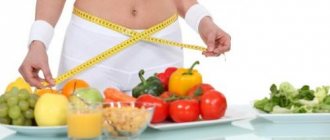Low-calorie diets emerged in the 1960s and 1970s as a quick and fairly mediocre way to lose weight. Experts of that time often created diets of 1000+ calories. However, they did not stop the obesity epidemic that was emerging at the time. The safety of diets was only questioned in the mid-1990s. Due to the development of knowledge in this area, contraindications have been limited.
What is a hypocaloric diet, its features
The principle of a hypocaloric or low-calorie diet is simple: consume fewer calories than you burn in a day. You need to adapt your diet to your lifestyle, that is, to the amount of physical activity. The hypocaloric diet is not restrictive, that is, you can eat everything, but in reasonable proportions. When a person follows a low-calorie diet, they typically consume between 800 and 1,500 calories per day. For some people, an alternative to rapid weight loss is a very low-calorie diet—less than 800 kcal/day.
Following a low-calorie diet means consuming between 1,000 and 1,500 calories per day. This creates a calorie deficit, which leads to weight loss. Such diets are effective, but it is not recommended to starve the body. Ideally, you should consult a nutritionist or doctor. The specialist will individually create a diet, taking into account all the nuances.
It is recommended that you undergo a physical examination before starting a low-calorie diet, especially if you have high blood pressure or elevated cholesterol.
Low-calorie diet and exercise
We get fat because we eat a lot and move little, therefore, our body receives significantly more calories than it needs to ensure normal functioning.
A low-calorie diet for weight loss is designed to help in the fight against excess weight. And this is mainly achieved by adjusting the diet. However, if you combine it with fitness classes, weight loss will become more effective. But there are some nuances here.
This diet plan is low-calorie; in addition, it does not exclude fasting days, so physical activity should be adequate and not exhausting.
Swimming, yoga, Pilates and dancing are good options. For beginners in sports, physical activity such as walking and the most common exercises at home is also suitable.
Important!
Refrain from sports during unloading. This can lead to health problems, in particular to disorders of the cardiovascular system.
Types of hypocaloric diet
There are 4 types of hypocaloric diet according to Pevzner, the choice of which depends on how much excess weight a person has:
- Diet 1800 kcal - this diet is suitable for those people who suffer from excess body weight, but have not yet developed obesity.
- Diet 1500 kcal - this diet is suitable for people with the first stage of obesity.
- Diet 1200 kcal - this diet is prescribed to people with second degree obesity.
- 800 kcal diet - such a diet can only be prescribed by a doctor and only to those people who suffer from 3-4 degrees of obesity. While observing it, a person must adhere to bed rest.
In addition, there are several more varieties:
- Cohen's diet. An individually tailored weight loss program, which is based on the results of a blood test, gender and age. Research conducted by Dr. Cohen has shown that obesity in many cases is caused by hormonal imbalance.
- Jenny Craig Diet. A low-calorie diet, which is based on a balanced diet (60% carbohydrates, 20% fats, 20% proteins).
- Montignac diet. The Montignac method is based on the principle of consuming carbohydrates with a low glycemic index.
Authorized Products
The basis of the diet of hypocaloric diets is:
- Lean varieties of red meat (veal, beef), poultry (chicken, turkey) and rabbit.
- Chicken eggs prepared in any way.
- River/sea fish (herring, hake, tuna, pike, salmon) in any culinary preparation, seafood (squid, mussels, crabs, oysters, shrimp).
- Legumes (beans, lentils, peas, chickpeas), mushrooms, seaweed.
- Cold-pressed vegetable oils (olive, sunflower, flaxseed, corn).
- Whole grain porridge (oatmeal, buckwheat, wheat).
- Low fat dairy/fermented milk products.
- Dietary varieties of bread/bread with the addition of crushed grains and bran.
- Vegetables rich in fiber (onions, carrots, cabbage, zucchini, eggplant, celery stalks, tomatoes, melons, zucchini, cucumbers, green beans), green salad leaves, garden herbs.
- Walnuts, olives, flax seeds.
Table of permitted products
| Proteins, g | Fats, g | Carbohydrates, g | Calories, kcal | |
Vegetables and greens | ||||
| eggplant | 1,2 | 0,1 | 4,5 | 24 |
| peas | 6,0 | 0,0 | 9,0 | 60 |
| green peas | 5,0 | 0,2 | 13,8 | 73 |
| zucchini | 0,6 | 0,3 | 4,6 | 24 |
| cabbage | 1,8 | 0,1 | 4,7 | 27 |
| broccoli | 3,0 | 0,4 | 5,2 | 28 |
| carrot | 1,3 | 0,1 | 6,9 | 32 |
| cucumbers | 0,8 | 0,1 | 2,8 | 15 |
| olives | 0,8 | 10,7 | 6,3 | 115 |
| iceberg lettuce | 0,9 | 0,1 | 1,8 | 14 |
| tomatoes | 0,6 | 0,2 | 4,2 | 20 |
| beans | 7,8 | 0,5 | 21,5 | 123 |
| green beans | 2,8 | 0,4 | 8,4 | 47 |
| lentils | 24,0 | 1,5 | 42,7 | 284 |
Nuts and dried fruits | ||||
| nuts | 15,0 | 40,0 | 20,0 | 500 |
| flax seeds | 18,3 | 42,2 | 28,9 | 534 |
Cereals and porridges | ||||
| buckwheat | 4,5 | 2,3 | 25,0 | 132 |
| oatmeal | 3,2 | 4,1 | 14,2 | 102 |
| millet porridge | 4,7 | 1,1 | 26,1 | 135 |
| brown rice | 7,4 | 1,8 | 72,9 | 337 |
Bakery products | ||||
| whole grain bread | 10,1 | 2,3 | 57,1 | 295 |
Dairy | ||||
| Ryazhenka | 2,8 | 4,0 | 4,2 | 67 |
Cheeses and cottage cheese | ||||
| cottage cheese | 17,2 | 5,0 | 1,8 | 121 |
Meat products | ||||
| boiled beef | 25,8 | 16,8 | 0,0 | 254 |
| veal | 19,7 | 1,2 | 0,0 | 90 |
| rabbit | 21,0 | 8,0 | 0,0 | 156 |
| bacon | 23,0 | 45,0 | 0,0 | 500 |
Sausages | ||||
| sausages | 10,1 | 31,6 | 1,9 | 332 |
| sausages | 12,3 | 25,3 | 0,0 | 277 |
Bird | ||||
| boiled chicken breast | 29,8 | 1,8 | 0,5 | 137 |
| turkey | 19,2 | 0,7 | 0,0 | 84 |
Eggs | ||||
| soft-boiled chicken eggs | 12,8 | 11,6 | 0,8 | 159 |
Fish and seafood | ||||
| seafood | 15,5 | 1,0 | 0,1 | 85 |
| canned fish | 17,5 | 2,0 | 0,0 | 88 |
| herring | 16,3 | 10,7 | — | 161 |
| cod (liver in oil) | 4,2 | 65,7 | 1,2 | 613 |
| tuna | 23,0 | 1,0 | — | 101 |
Oils and fats | ||||
| vegetable oil | 0,0 | 99,0 | 0,0 | 899 |
| butter | 0,5 | 82,5 | 0,8 | 748 |
| linseed oil | 0,0 | 99,8 | 0,0 | 898 |
Non-alcoholic drinks | ||||
| mineral water | 0,0 | 0,0 | 0,0 | — |
| green tea | 0,0 | 0,0 | 0,0 | — |
* data is per 100 g of product
Basic principles and rules of a hypocaloric diet
Say goodbye to junk foods loaded with unhealthy refined carbohydrates and trans fats. Healthy foods, steamed, boiled or baked, will help you lose weight without compromising your health. The main goal of the diet is to force the body to use more fat as fuel, instead of carbohydrates as the main source of energy.
Basic principles of the diet
Reducing the caloric content of the diet due to carbohydrates, especially easily digestible ones and, to a lesser extent, fats (mainly animals) with a normal protein content. Restriction of free fluid, sodium chloride and appetite-stimulating foods and dishes. Increased dietary fiber content. Dishes are prepared boiled, stewed, baked. Use sugar substitutes for sweet foods and drinks.
To prevent the loss of muscle mass that accompanies most fat loss, your diet should include adequate protein in the form of dairy products, as well as meat, poultry, fish, eggs or legumes, and tofu (lunch and dinner).
Hypocaloric diet: classic menu
A hypocaloric diet menu for a week, a month or several months can be drawn up independently or together with a nutritionist, taking as a basis the permitted types of foods. But when choosing dietary dishes for the day, it is important not to forget that the hypocaloric meal must comply with the rules of a balanced diet and contain products from different food categories in the daily diet.
When creating a menu for breakfast, it is important to consider that this meal contains a portion of fiber and a portion of protein. For example, it could be a regular omelet with vegetables, chicken with salad, which can be washed down with tea with milk or a chicory milk drink.
It is useful that the first hypocaloric snack contains milk protein (approximately 18-20 g of pure protein). To achieve this task, a serving of cottage cheese or yogurt is suitable. You can make a cottage cheese soufflé or a cocktail from yogurt and a handful of berries.
For lunch, it is important to select fiber-rich vegetables, as well as include a portion of protein (preferably with a minimum amount of fat) and a portion of complex carbohydrates in the menu. The best example of a dietary lunch is vegetable soup, a slice of whole grain bread, a piece of boiled or stewed meat or fish.
Experts advise making an afternoon snack from fermented milk products and vegetables. No ideas for menu options? How about a glass of kefir and steamed carrot (or other vegetable) cutlets? Nourishing, low-calorie and tasty.
The evening meal must contain one serving of protein and complex carbohydrates. Low-calorie, easily digestible and very healthy boiled buckwheat is almost ideal for dinner. You can cook fish with vegetables or meat with it (choose what you didn’t have at lunch). As a drink, herbal unsweetened tea or compote of fresh fruits or dried fruits is suitable.
People who find it very difficult to cope with hunger in the evening can drink a glass of kefir before going to bed.
To summarize, we can say that a hypocaloric diet is a balanced nutrition system with an emphasis on protein foods. When creating a diet menu, it is important to remember two rules: eat foods from all food categories every day and monitor the caloric content of your diet. Even minimal physical activity will help speed up weight loss. If excessive weight does not allow you to do aerobics, then for now your sports program may consist of several hours of walks in the fresh air. The main thing is to create a calorie deficit.
Who is this diet suitable for, the positive properties of the weight loss method
This diet definitely requires prior consultation with a doctor. The technique is designed for the body of an adult and healthy person. Moreover, even in cases of the absence of serious diseases or their occurrence in the initial stages in mild forms, nutritionists prefer to monitor the condition of patients during the entire diet.
The low-calorie diet is intended for obese or overweight people whose health conditions require weight loss. If a person's BMI is greater than 30, then low-calorie diets are generally safe with proper medical supervision.
Positive benefits of the diet include:
- Weight loss. Weight loss is the biggest benefit and the most common reason why people choose a low-calorie diet. The lower the number of calories consumed, the more intensely the body uses fat as fuel, thereby reducing weight.
- Ease of compliance. In order to control the number of calories consumed, you do not need to have special equipment. A scale and a calorie counting app are all you need.
- Improved insulin resistance. Low-calorie diets improve insulin resistance through weight loss.
- Reducing cholesterol levels. The diet involves eliminating trans fats and glucose, which helps reduce cholesterol levels.
Hypocaloric diet: example of a daily diet
Before you start losing weight, you need to prepare your body by gradually reducing the number of calories over several days. Food should be steamed, boiled, baked or eaten raw. Servings of soup should not exceed 250 grams, drinks - 200 milliliters, side dishes - no more than 150 grams, protein foods (meat, fish, seafood and cottage cheese) - 100 grams.
Friends! I, Andrey Eroshkin, will conduct mega interesting webinars for you, sign up and watch!
Topics of upcoming webinars:
- How to lose weight without willpower and prevent the weight from coming back?
- How to become healthy again without pills, the natural way?
- Where do kidney stones come from and what can be done to prevent them from appearing again?
- How to stop visiting gynecologists, give birth to a healthy child and not grow old at 40?
SIGN UP FOR THE WEBINAR
One day's menu might look like this:
- Breakfast: omelet with additives (tomatoes, zucchini), kefir or curdled milk.
- Lunch: steamed cutlets or meatballs, plus vegetable or cereal soup, as well as a piece of bread or a portion of crackers.
- Afternoon snack: some fruit or berries, such as mango, peach or a handful of currants, can sometimes be replaced with a portion of cottage cheese and pumpkin or other vegetable juice.
- Dinner: fish balls or cutlets with rice or potatoes, a glass of juice. Instead, you can eat porridge with water, vinaigrette, beef liver pancakes or a salad with a piece of bread.
- At night: have a snack with a glass of kefir or an apple.
By arranging the permitted foods and keeping in mind the size of the portions, it is easy to create a diet for both a week and three.
You should exit the diet gradually, gradually introducing foods not from the list of permitted ones.
When using a hypocaloric diet for obese children, you should follow the doctor's instructions, since the child's body reacts worse to the lack of certain substances.
When drawing up a menu for the thyroid gland, diseases of which require exactly the opposite restrictions, increased or, conversely, decreased iodine content, you should also check the list of permitted and prohibited foods with your doctor.
Disadvantages and contraindications
Disadvantages and side effects of these diets include:
- Fatigue. A calorie deficit can lead to decreased performance and decreased energy.
- Nausea, constipation and/or diarrhea.
- Risk of nutritional deficiencies. Vitamin and mineral deficiencies are possible, especially if you restrict entire food groups.
- Slowing metabolism. As you lose weight, your body will adapt. This is called adaptive thermogenesis. Considering AT, the metabolic rate can vary from 100 to 500 calories per day. If you consume less than 1200 kcal per day and do not lose weight, this may mean that your metabolism has slowed down.
- Women's athletic triad. The triad consists of three positions: negative energy balance, menstrual irregularities and low bone density. Negative energy balance can occur due to too much exercise, poor nutrition, gastrointestinal distress, or a combination of all three.
- Decreased muscle mass. Losing 0.5 kg to 1 kg per week can lead to a decrease in muscle mass. To avoid this, it is recommended to increase the amount of protein consumed.
A low-calorie diet is contraindicated in children and adolescents, as this can lead to delayed pubertal development, and in people over 70 years of age, in them it accelerates physiological muscle atrophy, potentially contributing to decreased activity. Experts emphasize that the diet is contraindicated for athletes and breastfeeding women.
Contraindications
Severe diabetic retinopathy , chronic renal failure , heavy physical labor, unstable angina , age under 18 years, gastrointestinal diseases, pregnancy / lactation, endocrine diseases, mental disorders, chronic constipation , coronary artery disease, high-grade arrhythmias gout , osteoporosis , acute infectious diseases , old age, atherosclerosis .
List of allowed foods for a hypocaloric diet
The number of calories you consume depends on many factors, including physical activity, gender, age, weight loss goals, and overall health. Most of the diet should consist of the following foods:
- Non-starchy vegetables: cabbage, arugula, spinach, broccoli, cauliflower, peppers, mushrooms, asparagus, tomatoes, etc.
- Fruits: berries, apples, pears, citrus fruits, melon, grapes, bananas, etc.
- Starchy vegetables: potatoes, peas, sweet potatoes, bananas, butternut squash, etc.
- Fish and shellfish: sea bass, salmon, cod, clams, shrimp, sardines, trout, oysters, etc.
- Eggs. Whole eggs are more nutrient dense than egg whites.
- Poultry and meat: chicken, turkey, beef, lamb, etc.
- Plant-based protein sources: tofu, tempeh, plant-based protein powders.
- Whole grains: oats, brown rice, farro, quinoa, bulgur, barley, millet, etc.
- Legumes: chickpeas, kidney beans, lentils, black beans and more.
- Healthy fats: avocado, olive oil, unsweetened coconut, avocado oil, coconut oil, etc.
- Dairy products: low-fat or low-fat plain yogurt, kefir and full-fat cheeses.
- Seeds, nuts and nut butters: almonds, macadamia nuts, pumpkin seeds, walnuts, sunflower seeds, natural peanut butter, almond butter and tahini.
- Unsweetened plant milks: coconut, almond, cashew and hemp.
- Seasonings: turmeric, garlic, oregano, rosemary, chili pepper, black pepper, salt, etc.
- Non-calorie drinks: water, sparkling water, coffee, green tea, etc.
List of permitted and prohibited products
Hypocaloric nutrition prohibits:
- Caffeine (no coffee, cola or energy drinks).
- Sugar, salt.
- Confectionery.
- Pasta, white bread, white rice.
- Smoked meats.
- Any fast food.
- Fatty meat, fatty fish.
- Grapes, bananas, raisins.
- alcohol.
While following hypocaloric nutritional principles, you can eat:
- Drink juice, water, weak tea, compote, decoctions (from rose hips, chamomile) are recommended.
- Almost all fruits, vegetables, greens.
- Low-fat cottage cheese, milk, kefir.
- Lean beef, chicken breast, lean fish.
- Boiled chicken egg, quail.
allslim.ru
Calorie table for low-calorie foods
Products to avoid
Reducing or limiting the following foods will speed up your weight loss and improve your overall health.
- Fast food: chicken nuggets, French fries, pizza, hot dogs, etc.
- Refined carbohydrates: white bread, sugar cereal, white pasta, bagels, crackers, corn chips, tortillas, etc.
- Sugar: candies, pastries, cakes, pastries, glucose, fructose, sucrose.
- Processed foods: packaged foods, processed meats (deli meats, bacon), packaged pasta dishes, cereal bars, etc.
- Fried foods: Potato chips, deep-fried foods, donuts, etc.
- Diet and low-fat foods: diet bars, low-fat ice cream, low-fat chips, diet frozen meals, low-calorie candy, etc.
- Sweetened drinks: soda, fruit juice, energy drinks, flavored dairy products, sweetened coffee drinks, alcohol.
Fully or partially limited products
During a hypocaloric diet, the following is prohibited/severely limited in the diet:
- Fatty red meat and poultry (duck, goose), smoked meats, sausages, lard, bacon, processed foods, fast food.
- Wheat bread, dough, crackers, bakery products (rolls, gingerbread, pies, cookies), waffles, cakes, pastries, pancakes, dumplings, dumplings.
- Sugar/products containing it, chocolate, candies, honey, halva, jam, dried fruits (dried apricots, raisins, figs, dates, prunes), condensed milk, ice cream,
- Sweet fermented milk products (yogurt with fruit additives), semolina porridge.
- Some vegetables (potatoes), sweet fruits (bananas, grapes).
- Alcohol-containing drinks (sweet/semi-sweet wines, beer), caffeine-containing products, hot/spicy sauces, seasonings.
Table of prohibited products
* data is per 100 g of product
Any person who is overweight has tried at least several times to go on some kind of fat-burning diet. A low-calorie diet is one of them. First of all, it is aimed at reducing calories consumed over a long period of time. Proponents of this diet are convinced that if you follow it for a long time, you can lose a few extra pounds without much effort.
In order for the human body to function normally throughout life, you should consume at least 1,500 calories per day. If a person gets carried away and reduces the amount of calories consumed to levels below the norm, he will constantly feel weak and tired.
Since the metabolic process in men and women occurs at different rates, the former need to consume 2500 calories, and the latter - 500 units less. However, it should be understood that these are only approximate figures, since the daily norm is calculated individually for each person. It depends on many factors: weight, age, gender, etc.
But since a hypocaloric diet is aimed at weight loss, you should reduce the number of calories consumed for a certain time. On average, a person uses from 1000 to 1500 calories on this diet. In this case, he lacks the energy that comes with food, and the body begins to draw it from the fat layer. This is how excess weight is lost.
Many experts are convinced that only a calorie deficit can promote weight loss.
In addition, they created a list of recommendations that should be followed while dieting:
Sample menu for the week
| Breakfast | Dinner | Dinner | |
| Monday | Boiled egg and avocado toast + green tea | Salad with grilled chicken and asparagus + chicory drink | Cod with quinoa and broccoli + fruit jelly |
| Tuesday | Cottage cheese casserole without flour, sugar + a glass of kefir | Lenten borscht + fish with cumin and garlic + side dish of vegetables + fruit jelly | Salmon with vegetables + green tea |
| Wednesday | Oatmeal with fruits and nuts + green tea | Pearl barley soup + fresh or pickled salad + apricot compote | Baked turkey with beans + tomato + green tea |
| Thursday | Two boiled eggs + toast with peanut butter and banana | Salad of Chinese cabbage, canned corn, herbs + a piece of boiled chicken + dried fruit compote | 1/2 cup cooked quinoa + 1 cup cooked asparagus + 2 teaspoons olive oil + boiled chicken breast |
| Friday | Boiled egg and avocado toast + green tea | Lenten borscht + fish with cumin and garlic + side dish of vegetables + fruit jelly | Baked turkey with beans + tomato + green tea |
| Saturday | Oatmeal with fruits and nuts + green tea | Pearl barley soup + fresh or pickled salad + apricot compote | Cod with quinoa and broccoli + fruit jelly |
| Sunday | Cottage cheese casserole without flour and sugar + a glass of kefir | Salad with grilled chicken and asparagus + chicory drink | Salmon with vegetables + green tea |
Hypocaloric diet: creating a nutrition menu
When planning your diet, it is recommended to adhere to some rules. Let's list them.
Firstly, there are foods that need to be completely eliminated.
- These are sausages, smoked meats, marinades and pickles, carbonated drinks, semi-finished products and fast food.
- Butter, margarine, ice cream, cheeses, mayonnaise, sour cream, and fatty meats are also prohibited.
- A taboo is also imposed on sweets, confectionery and bakery products made from premium flour, jam, sugar and other sources of quickly digestible carbohydrates.
Secondly, the consumption of caffeine, seasonings and salt is limited.
Thirdly, we’ll talk about what the food menu may consist of.
- The diet is based on lean meats, lean fish, seafood, white poultry, cereals, legumes, vegetables and fruits.
- It is better to choose dairy and fermented milk products with low fat content.
- Of the eggs, preference is given to quail eggs, but chicken eggs are not excluded, their norm is simply reduced to 2-3 eggs per week.
- Once a week you can treat yourself to mushrooms, as well as fatty sea fish (mackerel, salmon, etc.), which are a healthy source of essential omega acids.
- Whole grain bread is eaten, but in small quantities and only in the first half of the day (no later than 12.00 - 14.00).
Advice!
Properly distribute proteins, fats and carbohydrates from food. For breakfast and lunch, you can allow yourself all three components; during the second breakfast, you should give preference to proteins and carbohydrates, and during the afternoon snack and dinner, you should give preference to proteins, supplemented with a small amount of fiber.
An approximate daily food menu might look like this:
- In the morning, eat a mushroom omelette made from egg whites in vegetable oil. Complete your meal with a slice of whole grain bread and a cup of green tea without sugar.
- Second breakfast can consist of a green apple baked with cottage cheese and dried apricots.
- For lunch, prepare a vegetarian pickle soup, and also bake lean fish with green beans and tomatoes in the oven.
- In the afternoon, drink a glass of unsweetened yogurt and eat half a grapefruit.
- Dine with a portion of white meat chicken, complemented by a salad of fresh vegetables (cucumbers, tomatoes, celery, Chinese cabbage) seasoned with lemon juice.
Hypocaloric diet: nutrition rules for weight loss
The main principle of a hypocaloric diet is that its energy value is reduced by limiting the consumption of fast carbohydrates and fats, while maintaining the content of protein, vitamins and microelements. But this must be done gradually, otherwise the body will receive severe stress.
Reduce your calorie intake every 2-3 weeks by 200 units until it reaches 1300-1500 kcal. Stay on it until your weight normalizes.
An important requirement of this weight loss diet also concerns the number of meals. It is proposed to switch to fractional meals and eat 5 times a day: three main meals and two snacks. At the same time, carbohydrates and fats can be eaten only in the first half of the day (no later than 15.00-16.00), as for proteins, they are consumed evenly throughout the day. The energy value of the diet is distributed as follows: breakfast (25%), second breakfast (15%), lunch (30%), afternoon snack (10%), dinner (20%).
If you want the weight to go away faster, alternate the calorie content of your diet, that is, from time to time, either reduce or increase it, but at the same time remain within the established norm of 1300-1500 kcal. It is believed that this will help the body not go into saving mode. As a result, the metabolism will not slow down, and the weight loss process will remain at the set level.
This nutrition system has a special relationship with fasting days. When the diet preparation stage is underway, it is recommended to do it twice a week, and during it it is enough to do it once every seven days. At the same time, you can choose any option for a fasting diet, focusing on your taste and tolerance of certain products.
There are also recommendations regarding preferred cooking methods. The main task is to reduce the energy value, so it is suggested to cook by steaming, grilling, baking food in the oven or boiling.











